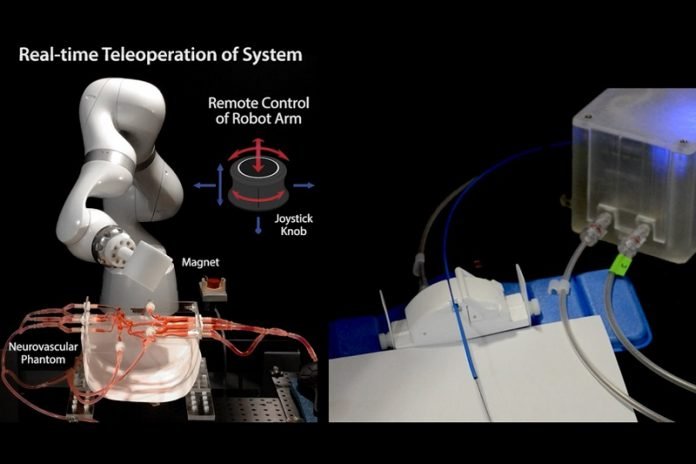
MIT engineers have developed a telerobotic system to help surgeons quickly and remotely treat patients experiencing a stroke or aneurysm.
With a modified joystick, surgeons in one hospital may control a robotic arm at another location to safely operate on a patient during a critical window of time that could save the patient’s life and preserve their brain function.
The robotic system, whose movement is controlled through magnets, is designed to remotely assist in endovascular intervention — a procedure performed in emergency situations to treat strokes caused by a blood clot.
Such interventions normally require a surgeon to manually guide a thin wire to the clot, where it can physically clear the blockage or deliver drugs to break it up.
One limitation of such procedures is accessibility: Neurovascular surgeons are often based at major medical institutions that are difficult to reach for patients in remote areas, particularly during the “golden hour” — the critical period after a stroke’s onset, during which treatment should be administered to minimize any damage to the brain.
The MIT team envisions that its robotic system could be installed at smaller hospitals and remotely guided by trained surgeons at larger medical centers.
The system includes a medical-grade robotic arm with a magnet attached to its wrist.
With a joystick and live imaging, an operator can adjust the magnet’s orientation and manipulate the arm to guide a soft and thin magnetic wire through arteries and vessels.
The researchers demonstrated the system in a “phantom,” a transparent model with vessels replicating complex arteries of the brain.
With just an hour of training, neurosurgeons were able to remotely control the robot’s arm to guide a wire through a maze of vessels to reach target locations in the model.
“We imagine, instead of transporting a patient from a rural area to a large city, they could go to a local hospital where nurses could set up this system.
A neurosurgeon at a major medical center could watch live imaging of the patient and use the robot to operate in that golden hour. That’s our future dream,” says Xuanhe Zhao, a professor of mechanical engineering and of civil and environmental engineering at MIT.
Zhao and his team have published their findings in Science Robotics.
Written by Jennifer Chu.



